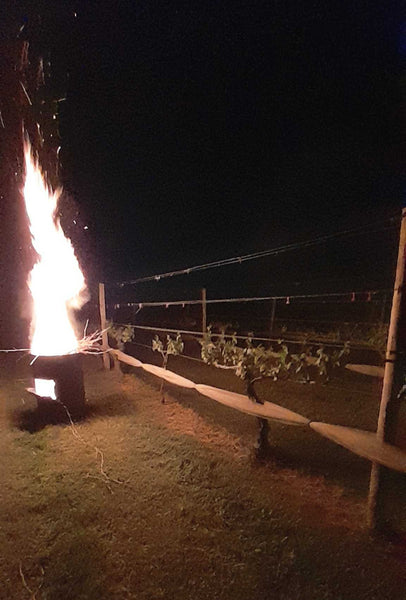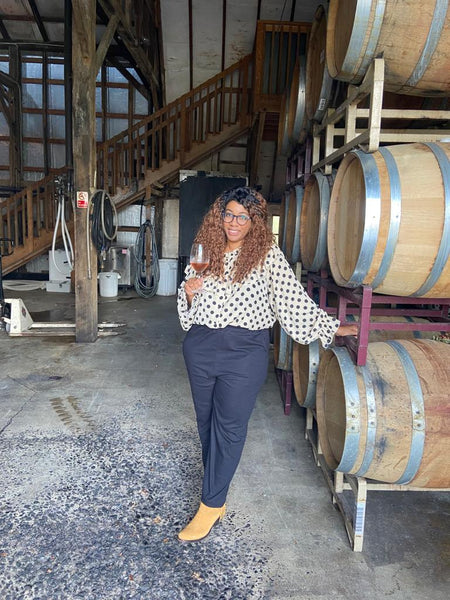Our Crew Works Towards Grand Cru
We are gearing up for harvest here at Unionville, with surefire signs like purpling Pinot Noir and golden Chardonnay reminding us that long hours, stained hands, and an opportunity to craft a whole new lot of sensational wine is just around the corner.
It is my favorite time of year. One of my favorite parts of working in a creative scientific field is our ability to look back on past vintages and learn from time and experiences (just as John described in his last post). This nostalgic analysis allows us to amend and alter different factors in the winery and vineyard in an experimental fashion, with an aim to improve wine quality or just try something different, fun, or special.
This growing season, we have been focusing on examining fruit set and adjusting crop yields, not only to ensure a clean and healthy fruiting zone but also to concentrate sugars, acids, and flavors in a more manageable crop load on the vine.

At Unionville, we like to crop our vineyards at between 2 and 4 tons of grapes per acre of planted vines (depending on the site and variety), and in the United States, we have the option to be fully flexible with this yield control. It is entirely up to us (and the weather) to manage the crop load and growing conditions – which is coupled with the responsibility of controlling the qualitative and economic consequences of our viticulture practices. This may seem like an obvious statement, but in almost all of the long-established winegrowing regions (affectionately referred to as the “old world”) there are rules and regulations controlling everything from allowable grape variety, to crop yields and allowed vineyard maintenance, to aging vessels and nutrient additions in different standards and classes of wine.
The idea of self-policing these strict regulations in an effort to emulate the regulation and standards of quality in our own vineyard practices sounds like an enticing experiment in control and enhancement. We looked to the French region of Burgundy for inspiration, where the designation of “Grand Cru” denotes the most distinct and consistent high-quality winegrowing sites of the area. Our winemaking and winegrowing philosophies for varieties such as Pinot Noir and Chardonnay have deep roots in the northernmost sites of Burgundy, such as Chablis and Dijon. Within these regions, the maximum amount of wine permitted to be made is 40 hectoliters per hectare (~400 gallons per acre) with numbers in various vintages often coming in much lower, this roughly equates to yields of around 1.5 – 2 tons of fruit per acre, so it seemed only right that we followed a similar maintenance procedure.
With that in mind, Alvaro and I chose four rows of our prized Pheasant Hill Chardonnay vineyard to green-thin down to a yield of 1.5 tons of fruit per acre. Venturing out early on a wet and chilly July morning, the two of us dropped more than half of the established Chardonnay clusters to the floor of the vineyard (yes, it was painful for both of us, but it was for the good of Science). By creating this variable and using the rest of the normally cropped Pheasant Hill Vineyard as a control, we hope to learn and further understand the control we have over quality assurance, sugar concentration, and overall wine potential from grape to bottle through this method.
These four rows will be monitored, analyzed, picked, processed, fermented, and aged separately from the control as our “Grand Cru” Chardonnay. As previously addressed, we are hoping to learn a lot about our control over quality potential and excited about the possibility of this small-batch wine being a fantastic addition to our STAMPED wine-club exclusive releases, or perhaps even a one-week-only sale in the tasting room.
No matter what the result of the experiment will be, enacting it has been half the fun and overall, an immensely rewarding experience. We will continue to try new things and start new trends at the winery, and I am sure I speak for all of us when I say how excited I am for the future. Great things happening at Unionville Vineyards – stay tuned!
- Conor Quilty, Associate WinemakerLeave a comment
Comments will be approved before showing up.
Also in Unionville Grapevine

Too Frigid For May: How Unionville Reacted to Destructive Frost

Meet Ahjiné Garmony, Unionville's New Wine Club Manager
Desk or vineyard? This is the question I asked myself when making the leap of faith to leave my corporate life behind to pursue my passion for wine. After working in the medical communications space for 10 years, 2022 was the year of epiphany. It may sound old fashion, but I did have a major realization in the beginning of the new year that I was not meant to work behind a desk and chug along doing work that I was no longer passionate about.
My first notion of my interest of wine came during my frequent business trips to Boston about 4 years ago. For the first time I was immersing myself in the world of wine through client dinners, networking events and a lot of self-exploring through Beantown. During this time was my first encounter with sommeliers and wine experts. I was fascinated and intrigued by the expertise knowledge of wine, wine making and learning about the intricacies that goes into producing a bottle of wine. At this moment, I thought about how amazing it was to witness such passion for the craft of wine.
I enrolled in an online sommelier level one course at the Wine School of Philadelphia and began studying and reading everything I could about wine. This is where my 2nd major epiphany happened – I asked myself, the question that I stated in the beginning “desk or vineyard?”
This is the question that started the major stepping stone to my journey. I no longer wanted my wine passion to be in the background – I wanted to be 100% committed and both feet in. Unionville Vineyards was the first winery that popped into my head when I thought about making my “9:00- 5:00” switch. I attended a wedding at Unionville the year prior and loved the atmosphere, the wine and the people. The position that I applied to was half farm work half hospitality. I was instantly attracted to the idea of being out in the field to where it all begins in wine making. Thoughts of my “office” transforming into the beautiful vineyard was something I desired. I was pleasantly surprised to learn that Unionville has multiple vineyard sites with the Coventry site located within Coventry Farm in Princeton being my favorite (love the views there!) Working at the different sites allows you to see how the different micro climates, soil and land impact the vines and fruit cluster growth. Also working in the field to me was the perfect learning opportunity to understand the craft of wine making soup to nuts. Being surrounded by vines that produced grapes such as Pinot Noir, Cabernet Sauvignon, Syrah, Chardonnay was eye opening to me. I was so used to seeing the finished product of these grape varietals in their bottled form, but actually being able to perform farming techniques on the vines starts to create another level of perspective and appreciation for wine.
One of my favorite farming tasks to perform in the field on the vines is leaf pulling. Leaf pulling is when you remove leaves from around the fruit clusters. The rule of thumb is to remove leaves that are across and below from the fruit cluster. Removing the leaves creates oxygen flow, openness for pesticides to be sprayed and exposes the fruit to more sunlight. I enjoy seeing the satisfying result of a perfectly balanced vine with the right number of leaves removed. Working in the field creates a huge bond between you and your other field peers. You become a family unit and learn how to work together and communicate as a team. To me, this is a very important factor for having a successful vineyard. My experience with people at Unionville in general has been amazing. You have the opportunity to interact with people from all different backgrounds (teachers, college, corporate, etc.) which makes for some great conversations and comradery.
To anyone reading this, do not be afraid to follow your passion and take a chance on doing what you want to ensure your happiness. It was scary to make such a drastic shift from corporate to farm work, especially since the two are extremely opposite ends of the spectrum, but I have no regrets and I am happy with where my career and focus is going.

